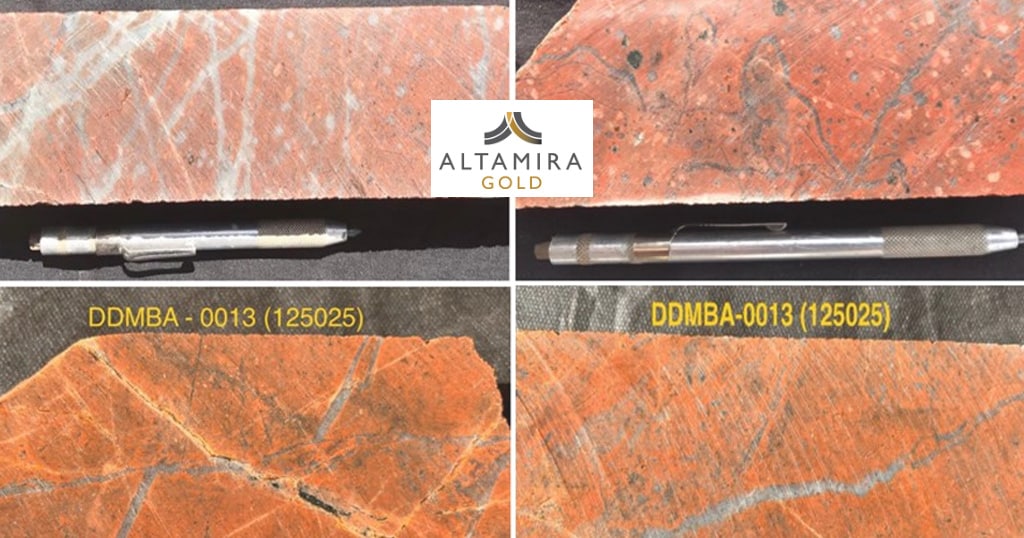Altamira Gold Corp. announce the results of the first six drill holes completed in the second drill campaign at the Maria Bonita gold discovery.
Highlights:
- DDMDA13 returned 139.4m @ 0.5 g/t gold from surface including 28m @ 0.9 g/t gold. DDMDA15 similarly returned 120.3m @ 0.5 g/t gold from 69.2m depth including 38.5m @ 0.9 g/t gold from 151m depth.
- DDMDA10 returned 160.0m @ 0.4 g/t gold from 36.0m depth including 31.2m @ 0.6 g/t gold from 79.4m depth and 6.2m @ 3.6 g/t gold from 245.5m depth.
- Four of the six holes completed confirmed the association of thick intervals (76-160m) of gold mineralization with a sub-cropping quartz porphyry rhyolite intrusive. This is the same host rock intersected in prior drilling and is now shown to be mineralized over approximately 250m east-west by 200m north-south.
- The wide gold mineralized intervals indicate an extensive mineralizing event within which the higher grades are related to the intensity of stockwork quartz veining. The well-developed stockwork lies within a broader envelope of alteration characterised by pervasive potassic, chlorite and sericite zones with varying degrees of quartz veining and lower grade gold mineralization.
- Drilling continues and logging and analysis of a further 13 holes is underway. The drill programme will also include HQ diameter metallurgical drillholes to provide samples to optimise the excellent gold recoveries achieved in leach testwork to date.
“Our initial step-out drillholes east and west of the prior discovery drilling have returned thicker, pervasively gold mineralized intervals in altered and veined intrusive rhyolites. These intervals, with consistent gold mineralization over up to 160 metres downhole, indicate that the mineralizing event is extensive and has continuity. Geologically, these results are consistent with the prior drilling in enlarging the gold mineralized footprint at Maria Bonita within the intrusive rhyolite. The area of sub-cropping, and low-cover mineralization identified in the prior drilling has been extended to the west for at least 100m. Hole MBA010 also intersected a deeper, higher-grade structure that provides us with the first vector towards a potential higher grade feeder zone to the mineralizing system.”
CEO Mike Bennett
CAJUEIRO PROJECT
The Cajueiro project is located approximately 75km NW of the town of Alta Floresta in the state of Mato Grosso (Figure 1) in central western Brazil and is easily accessible by road and has grid power. Cajueiro forms one of three key projects that Altamira controls in the region, the other two being Apiacas and Santa Helena (Figure1).
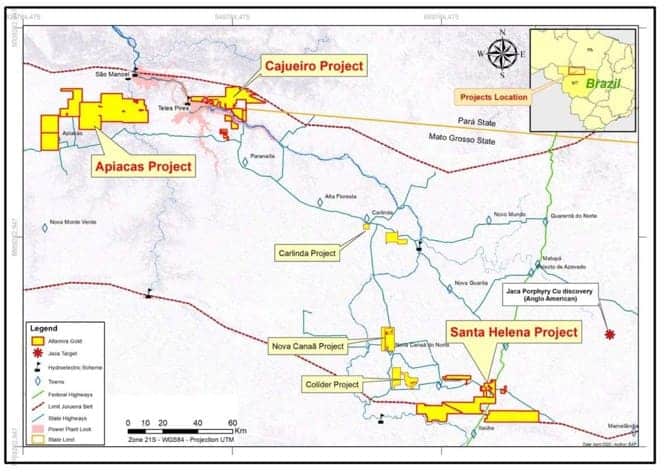
The Cajueiro project has current NI 43-101 resources of 5.66Mt @ 1.02 g/t gold for a total of 185,000 oz in the Indicated Resource category and 12.66Mt @ 1.26 g/t gold for a total of 515,000 oz in the Inferred Resource category (estimated using a gold price of US$1,500/oz).
Maria Bonita Target
Maria Bonita is located 7km west of the Cajueiro mineral resource and is easily accessible by road. The current drill programme is follow-up to the initial round of discovery drillholes which include 69m @ 1g/t gold in MBA005, 50m @ 1.1 g/t gold in MBA004, 55m @ 1.0 g/t gold in MBA002, 50m @ 1.0 g/t gold in MBA001 and 45m @ 1.4 g/t gold in MBA003 (all from surface). The gold mineralization is notably uniform in the initial discovery holes, with a peak assay value of 7.7 g/t Au. Initial metallurgical characterisation tests returned gold recoveries of 88% (column leach of saprolite) and 90% (agitated leach in saprolite and fresh rock) on composite drill core samples.
There is no outcrop in the project area, therefore this second drill programme is largely guided by the results of the prior drilling plus ground magnetics and soil survey data. Prior soil surveys have defined a pronounced soil anomaly over 400ppb Au measuring 250m by 300m, within a larger trapezoid-shaped magnetic low, bounded by interpreted structures (see Figure 2 and the press release dated 5th December 2023). The extensive magnetic low may reflect the hydrothermally altered package of host mineralized intrusive rocks (Figure 2).
This second drill programme aims to further the extent of the bedrock gold mineralization. To date in the current programme, 19 diamond core drillholes have been completed for a total of 3,245.7 metres. Results are presented for the first six drillholes (DDMBA010-015). The deepest hole in the current programme is 267m. Holes reported here and completed to date are shown in Figure 2 and Table 1.
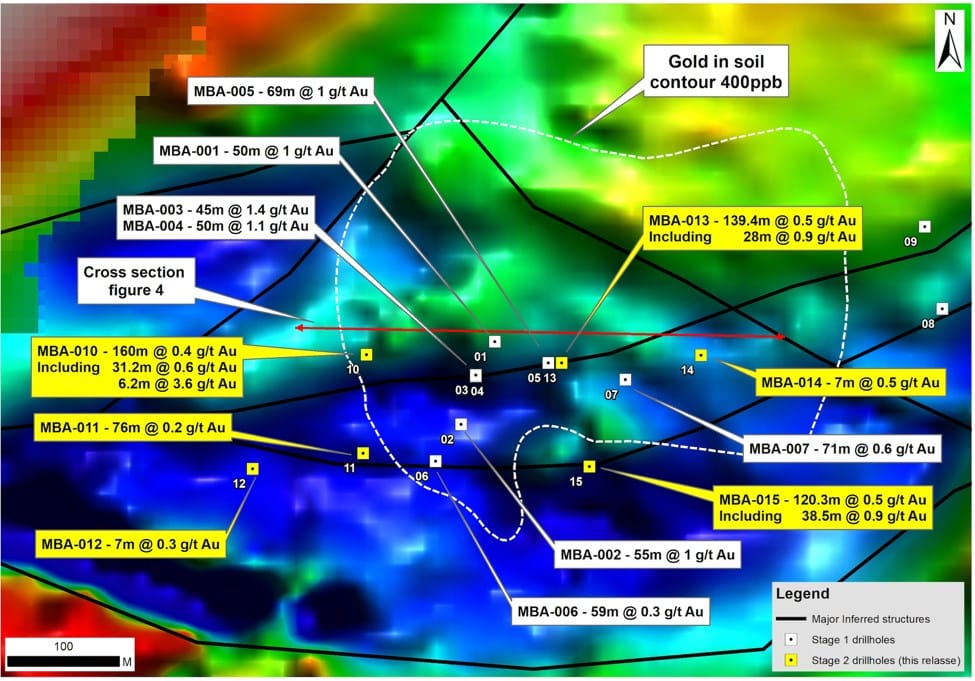
| Drillhole | Depth | From | To | Length | Grade | Peak assay | |
| metres | metres | metres | metres | Au g/t | Au g/t | ||
| DDMBA-0010 | 267 | 36.0 | 196.0 | 160.0 | 0.36 | 7.46 | |
| including | 79.4 | 110.5 | 31.2 | 0.56 | |||
| including | 245.5 | 251.7 | 6.2 | 3.59 | |||
| DDMBA-0011 | 148 | 0.0 | 76.0 | 76.0 | 0.23 | 0.61 | |
| DDMBA-0012 | 152 | 90.0 | 97.0 | 7.0 | 0.30 | 0.57 | |
| DDMBA-0013 | 139 | 0.0 | 139.4 | 139.4 | 0.47 | 1.47 | |
| including | 0.0 | 28.0 | 28.0 | 0.85 | |||
| including | 0.0 | 94.0 | 94.0 | 0.58 | |||
| DDMBA-0014 | 153 | 0.0 | 7.0 | 7.0 | 0.45 | 0.72 | |
| 67.0 | 72.0 | 5.0 | 0.32 | ||||
| DDMBA-0015 | 189 | 0.0 | 20.2 | 20.2 | 0.39 | 2.12 | |
| 69.2 | 189.5 | 120.3 | 0.52 | ||||
| including | 94.6 | 189.5 | 94.9 | 0.59 | |||
| including | 151.0 | 189.5 | 38.5 | 0.90 |
Holes MBA0010 and 0013 (Figures 2 and 3 are step-outs to the east and west of the original drill discovery. They both intersected a thick package of mineralized rhyolite intrusives with varying amounts of stockwork quartz veining. Holes MBA0011 and 0012 were drilled to the south-west of the discovery area. Hole 0011 intersected 76m of lower grade gold mineralization whereas Hole 0012, whilst intersecting the same intrusive rhyolite is interpreted as lying outside the mineralized zone.
Hole 0014, which is located to the east of hole 0007 (71m @ 0.6 g/t Au from 34m and 43m @ 0.5g/t Au from 105m) implies that the bedrock gold mineralization does not extend that far east although the saprolite mineralized zone is present (7m @ 0.45g/t Au from surface).
Hole 0015, collared 130m southeast of the discovery zone, intersected 120m at 0.52g/t Au with a higher grade 38.5m at 0.9g/t Au from 151m. This is currently the deepest intercept of wide, consistent mineralization to date.
The second phase drilling has confirmed that the host quartz porphyry rhyolite intrusive extends beyond the original drill footprint. Alteration zoning within the intrusive consists of higher temperature potassic and lower temperature sericite and chlorite zones. Gold is present in all types of alteration and has a variable correlation with both quartz vein intensity and magnetic susceptibility, implying that there is more than one phase of introduction of gold.
Later un-mineralized felspar porphyry dykes cross-cut the host quartz porphyry rhyolite and are interpreted to trend north-east through the drilled area.
The mineralized intrusive contains several zones with unidirectional solidification textures (UST) (see Figure 3b) which occur at greater depths than seen in the first round of drilling. These textures represent veining emplaced in a gell-like or plastic state whilst the intrusive host-rocks were cooling, as distinct from later, more linear vein sets and breccias that were introduced into a more rigid solid intrusive, post-cooling. They are indicators of the position of the drilled mineralization towards the top of the original intrusive body. Work continues to assess the relationship of gold grades to the specific vein directions and textures noted in the core, to define vectors towards higher grade mineralization and to guide further drilling.
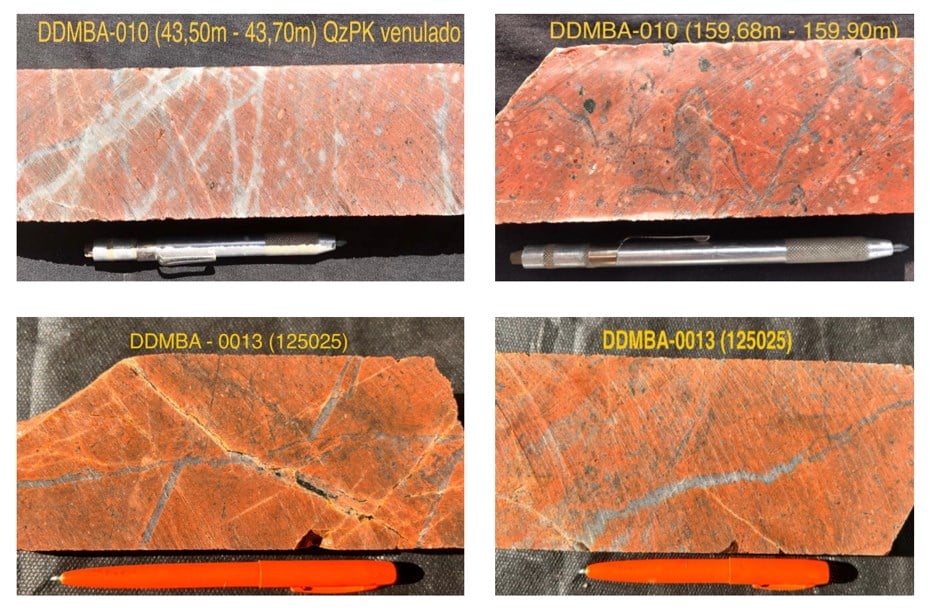
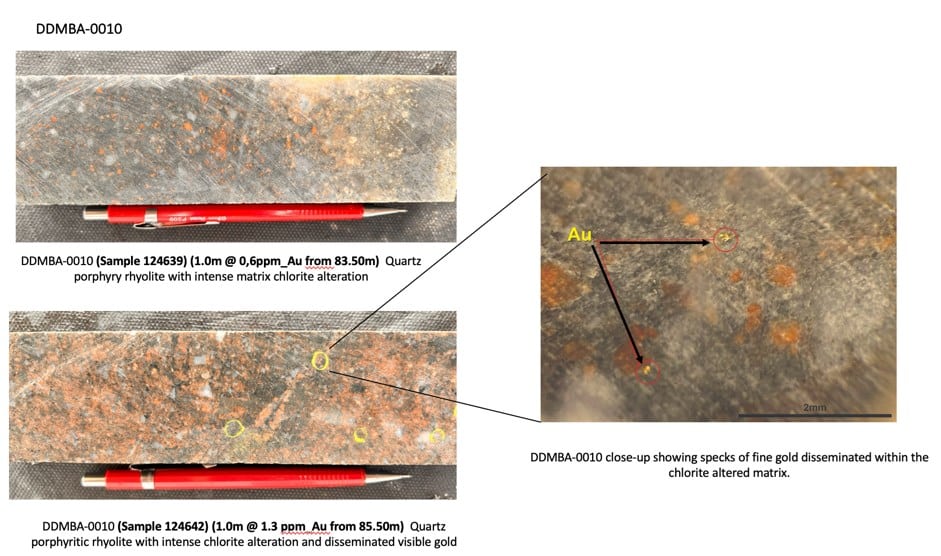
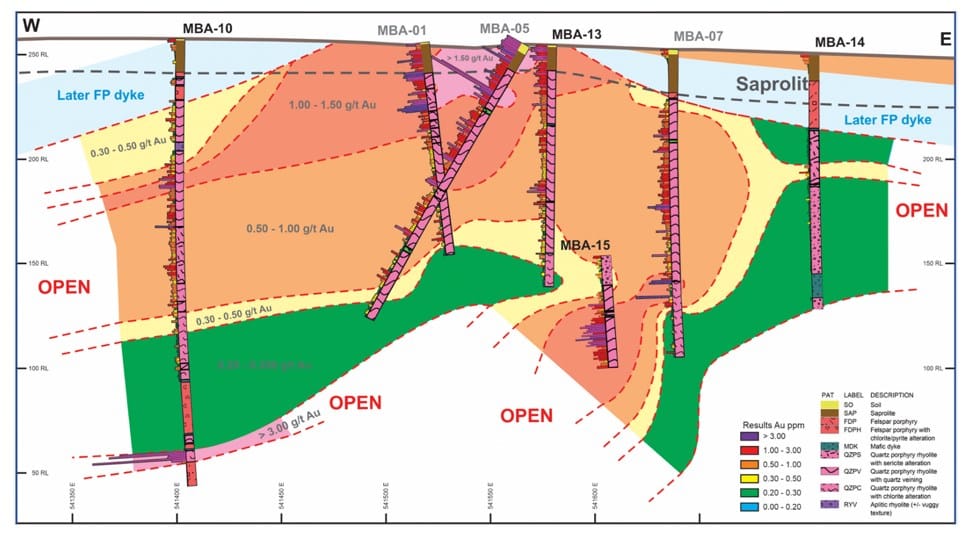
The interpretation shown in Figure 5 is a longitudinal section with drillholes projected onto the section. It shows the relative positions of the outcropping, higher grade mineralization, extending beneath the cover of a thin later dyke to the east and west. Hole MBA014 appears to close off the mineralization to the east whereas, to the east, the zone continues under cover. A second deeper mineralized trend is present in Hole 15 (collared off section) and remains open to depth.
One occurrence of visible gold was noted (MBA010) in a 1m assay interval reporting 1.26g/t Au (from 85.5m) (Figure 4). This gold occurs disseminated in chlorite-altered intrusive (as opposed to quartz veining), thus implying that it may be more widespread than recorded in logging. Follow-up screen fire assay is underway to check whether the standard 50g fire assay method used throughout may be under-reporting gold grades in this interval with relatively coarse gold.
The current drill results have successfully extended the footprint of consistent bedrock gold mineralization to both the east and west. The zone of mineralized quartz porphyry rhyolite, with an average grade >0.5g/t gold, has a true thickness of 80-120m in the area covered by the drill section. Drilling continues and logging and analysis of a further 13 holes is underway. The drill programme will also include HQ diameter metallurgical drillholes to provide samples to optimise the excellent gold recoveries achieved in leach testwork to date.
Qualified Person
Guillermo Hughes, FAIG and M AusIMM., a consultant to the Company as well as a Qualified Person as defined by National Instrument 43-101, supervised the preparation of the technical information in this news release.
About Altamira Gold Corp.
The Company is focused on the exploration and development of gold and copper projects within western central Brazil. The Company holds 6 projects comprising approximately 190,000 hectares, within the prolific Juruena gold belt which historically produced an estimated 7 to 10Moz of placer gold. The Company’s advanced Cajueiro project has NI 43-101 resources of 5.66Mt @ 1.02 g/t gold for a total of 185,000 oz in the Indicated Resource category and 12.66Mt @ 1.26 g/t gold for a total of 515,000oz in the Inferred Resource category.
On Behalf of the Board of Directors,
ALTAMIRA GOLD CORP.
“Michael Bennett”
Michael Bennett
President & CEO
Tel: 604.676.5660
Toll-Free:1-833-606-6271
[email protected]
www.altamiragold.com
Neither TSX Venture Exchange nor its Regulation Services Provider (as that term is defined in policies of the TSX Venture Exchange) accepts responsibility for the adequacy or accuracy of this release.
The securities described herein have not been registered under the U.S. Securities Act or any state securities laws, and may not be offered or sold in the United States absent registration or an applicable exemption from registration requirements under the U.S. Securities Act and any applicable state securities laws.
Forward-looking Statements
Certain information contained herein constitutes “forward-looking information” under Canadian securities legislation. Forward-looking information includes, but is not limited to, statements with respect to the extension of the Warrants. Generally, forward-looking information can be identified by the use of forward-looking terminology such as “will”, “intends” or variations of such words and phrases or statements that certain actions, events or results “will” occur. Forward-looking statements are based on the opinions and estimates of management as of the date such statements are made and they are subject to known and unknown risks, uncertainties and other factors that may cause the actual results to be materially different from those expressed or implied by such forward-looking statements or forward-looking information, including the receipt of all necessary regulatory approvals. Although management of the Company has attempted to identify important factors that could cause actual results to differ materially from those contained in forward-looking statements or forward-looking information, there may be other factors that cause results not to be as anticipated, estimated or intended. There can be no assurance that such statements will prove to be accurate, as actual results and future events could differ materially from those anticipated in such statements. Accordingly, readers should not place undue reliance on forward-looking statements and forward-looking information. The Company will not update any forward-looking statements or forward-looking information that is incorporated by reference herein, except as required by applicable securities laws.
Notes
Gold analysis has been conducted by SGS method FAA505 (fire assay of 50g charge), with higher grade samples checked by FAA525. Analytical quality is monitored by certified references and blanks. Until dispatch, samples are stored under the supervision the Company’s exploration office. The samples are couriered to the assay laboratory using a commercial contractor. Pulps are returned to the Company and archived. Drill holes results are quoted as down-hole length weighted intersections.










